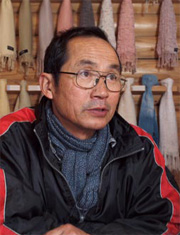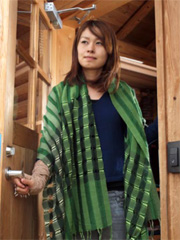Home > Highlighting JAPAN > Highlighting Japan JANUARY 2011 > Old-Style Looms Weave Contemporary Chic
Highlighting JAPAN
MONODZUKURI
Old-Style Looms Weave Contemporary Chic
A textile manufacturer in Imabari, Ehime Prefecture, is producing beautiful scarves with unique designs and textures using restored, old-style looms. Miho Yanagisawa visits the artisans of Kobo Oriza.

Masatoshi Takeda, president of Kobo Oriza
Called "tate-yoko yoroke mojiri-ori" (up-down staggered leno weave), this weave gives rise to patterns that look like ripples or fish scales. These days, almost all textile factories use high-speed looms that are capable of mass-production, but tate-yoko yoroke mojiri-ori products are woven on low-speed looms that were the mainstream technology until about 1970. With high-speed looms, the thread is constantly kept under high tension, but low-speed looms allow the freedom for some slack in the fabric, which produces unique textures and patterns.
Before starting his own workshop, Takeda worked for about forty years at a local towel factory, where he first encountered old-style looms. The factory had switched over to high-speed looms, but the owner wanted to open a museum of weaving looms, and put Takeda in charge of finding old ones.
"With low-speed looms, the slow weaving process results in a full, fluffy feeling as though the air has entered the fabric. I was attracted to the sense of warmth in the fabric the old looms produced," says Takeda.
Restoring Old-Style Looms
Adverse economic conditions meant that towel production in Imabari gradually lost its vigor, and in 2005 Takeda lost his job when the factory scaled back its operations.

Kobo Oriza scarves are richly colored and soft to the touch.
Low-speed looms are "fixed-width looms" that produce, one sheet at a time, fabric about 40 cm in width, which is the size of a roll of kimono cloth.
"Fixed-width looms weave at a width suitable for the product being made, so there is almost no sewing involved. This results in products that are beautiful and light, and which feel good to the touch."
According to Takeda, low-speed looms allow a free style of weaving where texture can be added in a way that is close to what is possible with hand-looms, precisely because they operate more slowly. The tate-yoko yoroke mojiri-ori weave was developed as a result of seeking a style of weaving that would give the people who wear the cloth a snug, cozy feeling. The slowly woven fabric keeps its shape well, and has numerous layers of air that make it soft and gentle to the touch.
In 2006, the year after his workshop was established, Takeda received first prize in the Audition for Business Seeds Leading to Business Creation run by the local Ehime Industrial Promotion Foundation. The products gradually became better known, winning the third Monodzukuri Nippon Grand Award in 2009 (the Minister's Prize from the Ministry of Economy, Trade and Industry). The workshop launched the ITO brand in 2010, focusing mainly on stoles. Products in the line have been well received for their originality and modern coloring, as well as their high quality, which is a result of the kind of technology used. The brand received the Good Design Award sponsored by the Japan Industrial Design Organization, and then received the Design for Asia Award sponsored by the Hong Kong Design Center in December. The products produced by Kobo Oriza are sought after by a wide-range of customers, with regulars praising the products for their "texture and volume" and as being "stylish and easy to wear."
There are now seven low-speed looms operating at Kobo Oriza, including two Toyota looms. Each loom can produce about thirty scarves per day.
"There might be a limit to how much we can produce, but I think that's OK if we can make products with high added value. I have new ideas for the next products that I want to make. Monodzukuri (artisanal manufacturing) is limitless, you know."
| Business name: | Kobo Oriza |
| Representative: | Masatoshi Takeda |
| Address: | Onihara kou 55, Tamakawa-cho, Imabari-shi, Ehime Prefecture, 794-0117 |
| Main activities: | Manufacturing and selling scarves and high-class craft textiles |
| Number of employees: | 7 |
| Website: | http://ito.oriza.jp/ |
© 2009 Cabinet Office, Government of Japan






